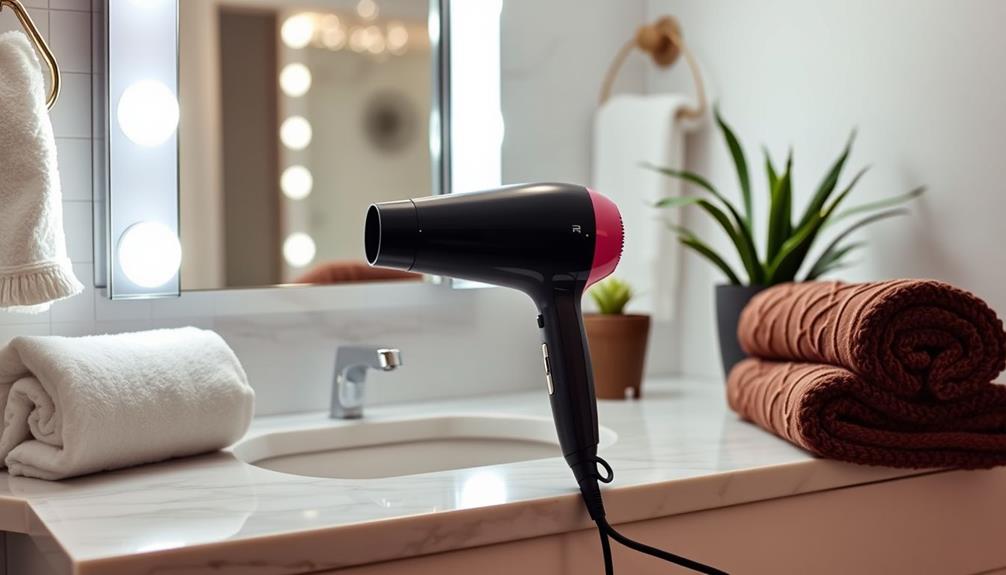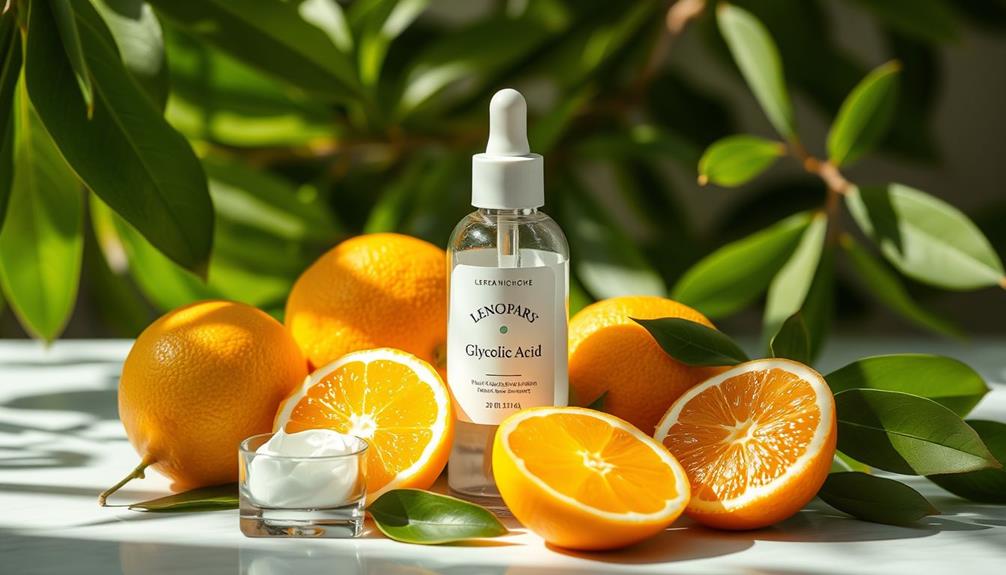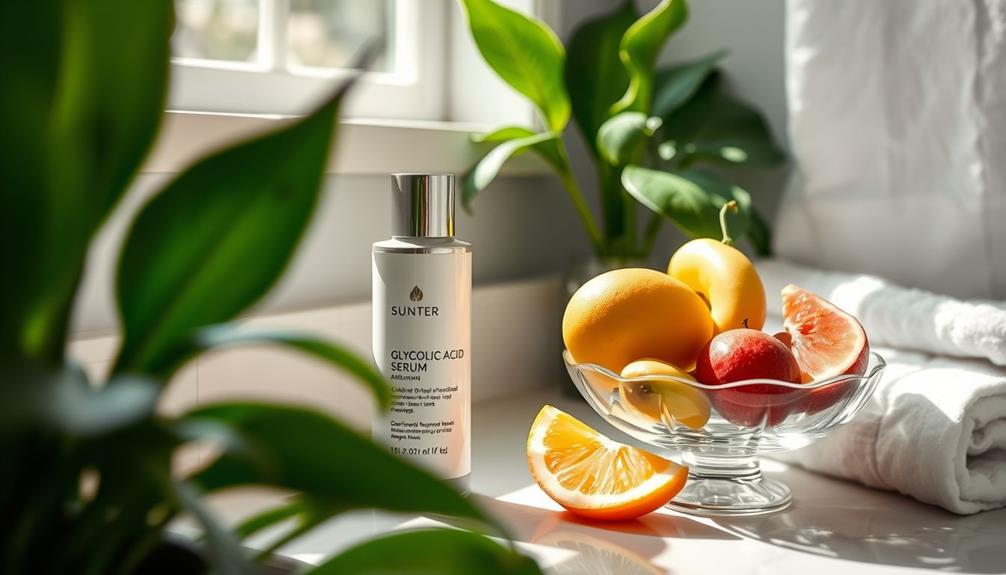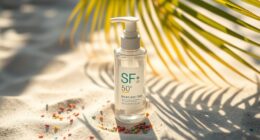Glycolic acid is your go-to for revitalizing your skin. This powerful alpha-hydroxy acid exfoliates, removing dead skin cells to give you a smoother texture. It helps reduce hyperpigmentation and signs of aging by promoting collagen production, leading to firmer skin. You'll also notice smaller pores and a brighter complexion. To start, use low concentrations a couple of times a week, gradually increasing as your skin adjusts. Remember to moisturize and apply sunscreen daily, as glycolic can make your skin more sensitive to the sun. There's so much more to uncover about integrating it into your routine!
Key Takeaways
- Glycolic acid is a powerful AHA that exfoliates skin, enhancing texture and promoting cell turnover by removing dead skin cells.
- It effectively treats hyperpigmentation, evening skin tone and reducing dark spots while stimulating collagen production for firmer skin.
- The small molecular size allows for deeper penetration, improving skin elasticity and promoting a more radiant complexion.
- Recommended usage starts with low concentrations, applied in the evening, followed by hydration and sunscreen to minimize irritation and sun sensitivity.
What Is Glycolic Acid?

Glycolic acid, a powerful alpha-hydroxy acid derived from sugar cane, is celebrated for its ability to exfoliate and enhance your skin's appearance. As the smallest AHA, its molecular size allows for deeper penetration into your skin, making it particularly effective in addressing various skin concerns.
When you incorporate glycolic acid into your skin care routine, it works by loosening the bonds between dead skin cells, which promotes cell turnover. This process reveals the brighter, smoother skin underneath, giving you a more radiant complexion.
Aromatherapy techniques can complement your skincare routine by promoting relaxation and enhancing overall well-being.
You can find glycolic acid in various formulations, typically in concentrations ranging from 5-10% in over-the-counter products like cleansers, toners, masks, and serums.
By regularly using glycolic acid, you're not just exfoliating; you're also improving your skin's texture and tone. Many people turn to glycolic acid for its versatility, especially when targeting issues like acne and the visible signs of aging.
Including this remarkable acid in your regimen can transform your skin, making it feel rejuvenated and revitalized.
Benefits of Glycolic Acid

Incorporating glycolic acid into your skincare routine offers a multitude of benefits that can dramatically enhance your skin's appearance and health. This powerful ingredient is known for removing dead skin cells, which helps you exfoliate your skin effectively. As a result, you'll notice a smoother and brighter skin tone.
Glycolic acid is particularly effective in treating hyperpigmentation and dark spots, promoting a more uniform complexion. Plus, it stimulates collagen production, improving skin firmness and elasticity while reducing the signs of aging such as fine lines and wrinkles. Additionally, regular use can minimize the visibility of pores by preventing clogging and reducing excess oil buildup.
Here's a quick overview of the benefits:
| Benefit | Description |
|---|---|
| Exfoliation | Removes dead skin cells for a smoother texture |
| Hyperpigmentation Treatment | Evens out skin tone and reduces dark spots |
| Anti-Aging | Stimulates collagen for firmer, more youthful skin |
How Glycolic Acid Works

As an alpha-hydroxy acid (AHA), glycolic acid effectively loosens the bonds between dead skin cells, making it easier for your skin to shed them and reveal a fresh layer underneath.
This process is known as chemical exfoliation, and it encourages your skin to exfoliate more efficiently, promoting cell turnover. Glycolic acid has a small molecular size, allowing it to penetrate deeply, which means it can exfoliate the skin on both superficial and deeper levels depending on its concentration.
Additionally, incorporating natural products such as essential oils, like lavender oil, can enhance your skincare routine by promoting relaxation and improving overall well-being.
At lower concentrations, around 5-10%, glycolic acid gently exfoliates the outermost skin layer. However, higher concentrations used in chemical peels target the outer and middle layers for more intensive treatment.
Beyond exfoliation, glycolic acid also stimulates collagen production, which helps improve skin firmness and elasticity over time. This can lead to a noticeable reduction in fine lines and wrinkles.
Additionally, glycolic acid enhances the absorption of other skincare products, so active ingredients like vitamins penetrate more effectively.
With consistent use, you can achieve improved skin texture and a healthier overall appearance, making glycolic acid an essential part of your skincare routine.
Application Techniques

To achieve the best results with glycolic acid, start by using a low concentration product and apply it to clean, dry skin once or twice a week to gauge your skin's tolerance.
Before diving in, it's wise to conduct a patch test on a small area to check for any adverse reactions, particularly if you have sensitive skin types.
Additionally, consider incorporating a safe alternative to UV tanning methods for an overall glowing complexion while using glycolic acid, as both can contribute to radiant skin Ultimate spray tan options.
Begin with a product containing around 5-10% glycolic acid.
First, use a toner or cleansing pads to remove any residue, ensuring your skin is primed for maximum effectiveness.
When you apply glycolic acid, adhere to the recommended application times; for at-home peels, avoid exceeding one to two minutes initially to prevent irritation.
Always apply glycolic acid in the evening.
This timing helps minimize sun sensitivity and protects your skin from potential damage.
After using glycolic acid, it's crucial to incorporate a hydrating product.
This step will alleviate any dryness and help maintain moisture balance in your skin.
Usage Recommendations
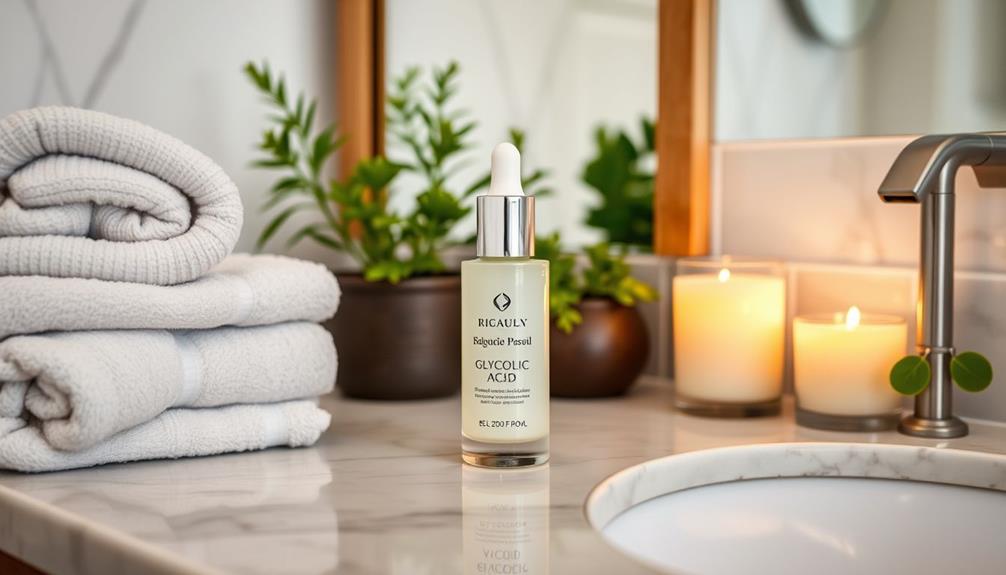
When you're starting with glycolic acid, it's essential to follow some beginner usage guidelines to avoid irritation.
Emphasizing a holistic lifestyle approach can enhance your skin's overall health while using glycolic acid.
You'll want to gradually adjust the frequency of application based on how your skin responds.
Additionally, incorporating effective post-application care can help maintain your skin's health and balance.
Beginner Usage Guidelines
Starting with a glycolic acid concentration of 5-10% and applying it once or twice a week helps you gauge your skin's tolerance.
Before diving into your new skincare routine, it's important to conduct a patch test on a small area, like the inner elbow or behind the ear. This step guarantees you won't experience any adverse reactions.
Once you've confirmed your skin can handle glycolic acid, gradually increase the frequency of application as tolerated. You might work your way up to nightly use after your skin has acclimatized.
It's necessary to apply glycolic acid on clean, dry skin in the evening to minimize sun sensitivity and maximize its effectiveness.
Don't forget to follow up with a broad-spectrum sunscreen (SPF 30+) during the day. Glycolic acid can make your skin more sensitive to the sun, so protecting it's crucial.
Application Frequency Recommendations
Gradually increasing the frequency of glycolic acid applications helps your skin adapt while minimizing the risk of irritation.
If you're new to glycolic acid, start with a concentration of 5-10% and limit your applications to once or twice a week. This approach allows you to assess your skin tolerance effectively.
As your skin becomes accustomed to the acid, you can gradually increase the frequency. Aim for nightly use after about 4 to 6 weeks, ensuring you incorporate it into your evening skincare routine. Apply it after cleansing and make sure your skin is dry for ideal absorption.
If you're looking to enhance exfoliation, consider using glycolic acid masks or peels every other week. Just keep an eye on any signs of irritation or sensitivity, especially if you have sensitive skin.
Remember, consistent monitoring is key as you adjust your application frequency. Always finish your routine with broad-spectrum sunscreen during the day, since glycolic acid can increase your skin's sensitivity to UV rays.
Following these application frequency recommendations will help you enjoy the benefits of glycolic acid safely and effectively.
Post-Application Care Tips
After you've applied glycolic acid, it's important to follow up with proper post-application care to guarantee your skin stays hydrated and protected. Here are some key tips to keep in mind:
| Tip | Details | Frequency for Beginners |
|---|---|---|
| Moisturize | Use a rich moisturizer to combat dryness. | Every application |
| Sunscreen | Apply broad-spectrum SPF 30+ the next morning. | Daily, especially after use |
| Soothing Products | If you experience redness or irritation, opt for hydrating ingredients like niacinamide or squalane. | As needed |
| Avoid Strong Actives | Don't mix with retinoids or other strong exfoliants. | Every application |
| Monitor Skin Response | Adjust the frequency based on your skin's reaction. | Start 1-2 times a week |
Potential Side Effects
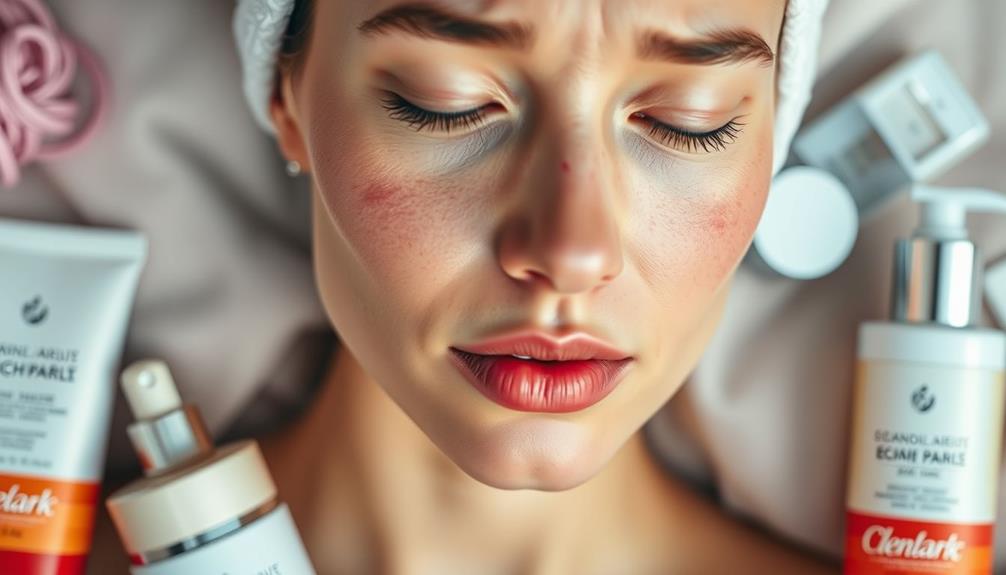
Glycolic acid can cause side effects like redness, stinging, and dryness, especially if you have sensitive skin. These reactions are often mild but can be uncomfortable. If you overuse glycolic acid, you might experience more severe issues like chemical burns or increased irritation.
It's vital to monitor how your skin responds and adjust your application frequency accordingly. When you first start using glycolic acid, mild peeling or flaking can occur as your skin adjusts to the exfoliation process. This is normal, but you should be aware of your skin's sensitivity level.
To minimize potential side effects, consider doing a patch test before fully incorporating glycolic acid into your routine. This can help identify any allergic reactions or heightened sensitivity.
Another significant factor to remember is sun sensitivity. Glycolic acid can make your skin more prone to sunburn, so applying a broad-spectrum sunscreen daily is essential. This protective step will help safeguard your skin and maintain its health while you enjoy the benefits of glycolic acid.
Always prioritize your skin's comfort and health to achieve the best results.
Expert Tips for Best Results

To get the best results from glycolic acid, it's essential to use it correctly and consider your skin type.
You'll want to pay attention to how your skin reacts and adjust your routine accordingly.
Let's explore effective usage techniques, skin type considerations, and post-application care to maximize your benefits.
Proper Usage Techniques
Using glycolic acid effectively starts with choosing the right concentration and frequency to let your skin adjust without irritation.
Begin with a low concentration of 5-10% and first apply it once a week. Gradually increase the frequency to 1-2 times a week as your skin acclimates. Always use glycolic acid on clean, dry skin in the evening, as this helps prevent increased sun sensitivity. Remember to follow up with a broad-spectrum sunscreen during the day.
Before diving into your routine, conduct a patch test on a small area, like your inner elbow, to check for any adverse reactions.
When incorporating skincare products with glycolic, consider combining them with hydrating ingredients such as hyaluronic acid to counteract dryness.
It's essential to avoid using glycolic acid at the same time as other strong actives, like retinoids or other exfoliants, to prevent over-exfoliation and irritation.
The pH level of your glycolic acid product can also influence its effectiveness, so keep that in mind as you explore various options.
Skin Type Considerations
Different skin types react uniquely to glycolic acid, so tailoring your approach guarantees the best results for your skincare routine. Glycolic acid is suitable for all skin types, including normal, combination, oily, and aging skin.
However, if you have very dry or highly sensitive skin, you should approach with caution and consider using lower concentrations.
Start with a glycolic acid concentration of 5-10% and use it 1-2 times per week. Monitor your skin's tolerance and response, gradually increasing frequency as needed.
Remember that seasonal changes can affect your skin sensitivity; you may want to increase usage during winter when skin tends to be drier and decrease it in summer when sun sensitivity is heightened.
Always conduct patch testing on a small area, like your inner elbow, before incorporating glycolic acid into your routine. This helps determine your skin's compatibility.
For younger individuals, especially those under 18, it's wise to stick to lower concentrations and be mindful of potential skin reactions due to developing skin sensitivities.
Post-Application Care
After applying glycolic acid, prioritizing hydration and sun protection is essential for maintaining your skin's health and enhancing the benefits of your skincare routine. Here are some expert tips to guarantee peak post-application care:
| Step | Action | Purpose |
|---|---|---|
| 1. Moisturize | Apply a hydrating moisturizer | Combats dryness and irritation |
| 2. Hydration | Use products with hyaluronic acid | Replenishes moisture levels |
| 3. Sunscreen | Use broad-spectrum SPF 30 | Protects against increased sun sensitivity |
| 4. Monitor | Check for redness or peeling | Guarantees skin isn't overly irritated |
| 5. Avoid Mixing | Skip strong exfoliants | Reduces risk of irritation |
Conclusion
Incorporating glycolic acid into your skincare routine can be like revealing a fresh canvas.
Imagine your skin glowing with renewed energy, as dead cells melt away, exposing a smoother, brighter complexion beneath.
With each application, you're not just treating your skin; you're transforming it.
Embrace the journey and watch your confidence bloom like a flower in spring.
Remember to listen to your skin, and soon you'll enjoy the radiant results that glycolic acid promises.

